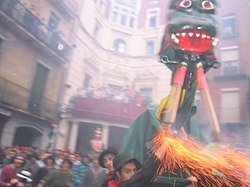Patum de Berga

The Patum de Berga, or simply "La Patum", is a popular and traditional festival that is celebrated each year in the Catalan city of Berga during the Solemnity of Corpus Christi. It consists of several performances of mystical and symbolical figures that dance to the rhythm of a big drum and vivid music. The balls are marked for their solemnity and the use of fire and pyrotechnics.
It was declared a Traditional Festival of National Interest by the Generalitat de Catalunya in 1983, and as a Masterpiece of the Oral and Intangible Heritage of Humanity by UNESCO in 2005.
Parades
- El Tabal (The Drum)
- Turcs i Cavallets (Turks and Little Horses)
- Les Maces (The Maces)
- Les Guites (The Mules)
- L'Àliga (The Eagle)
- Els Nans Vells (The Old Dwarves)
- Els Gegants (The Giants)
- Els Nans Nous (The New Dwarves)
- Els Plens (The "Plens")
Origins and significance
Those who visit Berga on Thursday and on Sunday of Corpus Christi or on Wednesday and on Saturday evening, could easily feel the festive atmosphere of 'La Patum'. The fire, the smoke and everyone jumping up and down, dancing and drinking will enable you to participate in a celebration which, after a number of changes, originated in the popular and religious theatre of the Middle Ages. Giants, devils, and bizarre-looking monsters parade through many towns in Catalonia during Patum de Berga.
Mr. Joan Amades, a Catalan writer, whose books talk about Catalan folklore devoted many pages to 'La Patum' in his book 'Costumari Català' (Customs of Catalonia). According to Mr. Amades, "Nowhere else will you find a celebration of Corpus Christi similar to the one in Berga".
Mr. Amades observes that some ancient processional dances set up this celebration, dances which have "magnificence and an enormous vitality" he says. These dances -which leave the eucharistic sense behind- are the core of 'La Patum' making it "a show of popular theatre which is something unique", says Mr. Amades. He says that he does not know anywhere else in the country where the ancient dances are "a set so harmonic, so spectacular". He qualifies that these dances have to be seen "in the simplicity of the square theatre and the poor elements which people had when these performances were played. A time of simplicity but a time of fulfilment". These remarks confirm Mr. Amades opinion that: "La Patum is a document of archeological value in the sense of performances which had taken part in the eucharistic celebration."
Manuel Riu (a Catalan writer) in 1955 considered La Patum "as a holy drama, mimic and rhythmical, which is developed outside in a square and which is a forerunner of the modern theatre".
Anthropologists and specialists in folklore have been interested in La Patum.
